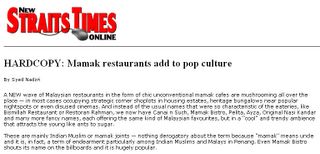
Mamak Restaurants - A New Malaysian Pop Culture?

Adstracts from:
HARDCOPY: Mamak restaurants add to pop culture
By Syed Nadzri, NST
A NEW wave of Malaysian restaurants in the form of chic unconventional mamak cafes are mushrooming all over the place — in most cases occupying strategic corner shoplots in housing estates, heritage bungalows near popular nightspots or even disused cinemas.
And instead of the usual names that were so characteristic of the eateries, like Bismillah Restaurant or Restoran Rahman, we now have Canai n Such, Mamak Bistro, Pelita, Ayza, Original Nasi Kandar and many more fancy names, each offering the same kind of Malaysian favourites, but in a "cool" and trendy ambience that attracts the young like ants to sugar.
These are mainly Indian Muslim or mamak joints — nothing derogatory about the term because "mamak" means uncle and it is, in fact, a term of endearment particularly among Indian Muslims and Malays in Penang. Even Mamak Bistro shouts its name on the billboards and it is hugely popular. The explosion is most evident in the Klang Valley and Penang.
What’s interesting about these restaurants is that they know how to attract the customers, particularly the young crowd and the yuppies — big screen TVs with amplified sound systems ideal for live football, comfortable chairs and tables not unlike the ones at Starbucks, brightly-lit interiors with clear colourful menu boards on the wall and ample outdoor tables.
I asked Muslim Restaurant Owners Association of Malaysia president Jamarulkhan Abdul Kadir the other day about what is causing the mamak restaurant boom and his answer was simple: A supply and demand situation. He said the concept of the restaurants works on young people — food and entertainment blending just nicely with the environment.
"Many of the restaurants offer a sidewalk café kind of environment at just a fraction of the prices in the designer coffee shops," he added. "Where in the world can you get a piece of roti canai for 80 sen and thosai for RM1? Only in Malaysia. In India you pay 35 rupees for thosai and that’s about RM3. By being a 24-hour operation, we provide a cheap alternative to pubs, discos and clubs. Many young people flock to our restaurants to watch live soccer matches, just as some do in pubs and bars. Ours therefore provide clean fun because we don’t serve alcohol and we are too open for undesirable activities like drug-taking by our customers."
The restaurants also appeal to working professionals — not only those looking for quick meals but business lunches as well. According to Jamarulkhan, he has seen many business deals being concluded across the tables of mamak restaurants after fish-head curry treats. Jamarulkhan, who runs the Restoran Syed chain, however said opening a new wave restaurant requires a lot of investment.
"Those days, you only need to spend about RM30,000 to start a decent restaurant. With this new concept, you need something between RM300,000 and RM1 million. "But the returns can be good."
Jamarulkhan said many of the owners of mamak restaurants are carrying on a family business into the third or fourth generation. Although some of the restaurants have many branches, they are not a franchised trade.
CRITICAL ANALYSIS
So, is Mamak Restaurant our new Malaysian Pop Culture?
I do not think so. Many at times, it is a matter of convenience and simplicity whenever a group of people wants to meet and to find a place to chat, and at the same time, you can have a nice hot drink, something to eat, even at times, to watch football or Formula 1; and Mamak's place can smoke-lah.
The advantage of these Mamak Restaurant is that they not only provide all the basic needs for groups of people looking for a place to lepak, or to chat, they also provide good service, open-air seatings, and are often spacious - they occupy all the car parks and walk-ways in front of their shops. Tak ada salah-lah! Semua pun macam tu! Bandaraya enforcement.... no problem-lah!
But the food aren't cheap ... you know why-lah ...got to pay rent and for Kudusism security services also (protection money -oh). [Period]
Direct Competition for the Mamak Restaurants are the burgeoning number of Food Courts and Hawker Centers. Again, you can see that these food courts provide many varieties and choices of food, drinks, LCD projectors and Large-screen, etc. The non-Muslim in particular may want an alcoholic drink which are available at food courts.
The Muslims of course would prefer the Mamaks in view of the fact that it is Halah. Food courts tend to be multi-racial in nature.
Are Mamak restaurants and food courts becoming Malaysian Pop-culture? I doubt. It's more a convenient place to meet in groups and are less expensive than pubs, karaokes, discos, etc. Furthermore, times are bad now as there are no more mega projects; so have to cut expenses as our wallets are taking routine slimming courses; we now have less disposable income to lepak - so, no more pubs, coffee-house, etc - road-side stall is Ok-lah!
Long live, the Mamak Restaurants!
No comments:
Post a Comment